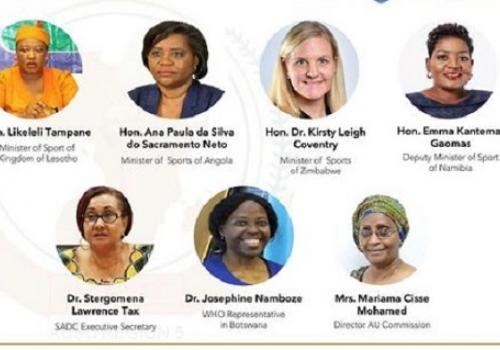Southern African Development Community (SADC) has been committed to promoting gender equality and women empowerment since its establishment, the Executive Secretary of SADC, Her Excellency Dr. Stergomena Lawrence Tax, has said.
Speaking during a virtual Panel Discussion hosted by African Union Sports Council Region 5 on 15 March 2021, Dr Tax said Article 5 (1) (k) of the SADC Treaty that was adopted in 1992 recognizes mainstreaming of gender as one of SADC's objectives and an integral process of community building.
She said the Regional Indicative Strategic Development Plan (2010-2020, as revised in 2015, outlined nine targets which aimed at empowerment of women, elimination of all forms of discrimination and to achieve gender equality.
Dr Tax, who spoke on the topic "Regional Strategies to safeguard the rights of women and girls. Are there any targets and milestones?" highlighted that SADC has developed a number of legislation, policies, strategies, and programmes to ensure that the targets are achieved. Some of the targets and milestones are:
- Protocol on Gender and Development of 2008, that was revised in 2016. The protocol aims to empower women, eliminate discrimination, and to achieve gender equality and equity, a feat that has been achieved by most Member States, through the enactment of legislation and formulation of policies;
- SADC Framework for Achieving Gender Parity in Political and Decision-Making positions of 2008. The framework provides strategies and guidelines for strengthening the implementation of the SADC Protocol on Gender and Development in order to ensure at that least 50 percent of all decision-making positions at all levels are held by women by 2030. Member States are at different levels of implementation, but on average, female representation in parliaments increased from 22.2% in 2009 to 25% in 2020, some have reached 45% some are still at lower than 10%. The framework aims to ensure that at least 50 percent of all decision-making positions at all levels would be held by women by 2030;
- 10 Year SADC Strategic Plan of Action on Combating Trafficking in Persons, especially women and children (2009-2019). This is a SADC plan that guides regional response, and is premised on the understanding that women and girls are vulnerable to trafficking in persons as a result of the inequalities that are rooted in social systems. Notable success has been achieved in this area as 14 Member States have put in place legislation on trafficking in persons. The objective is to combat Trafficking in Persons, especially women and children who are particularly vulnerable by 2030;
- Regional Multi-Dimensional Women's Economic Empowerment Programme. This promotes women's economic empowerment and gender-responsive development in order to contribute to social inclusion and justice by 2030. The implementation is ongoing across Member States. The programme aims to promote women's economic empowerment and gender-responsive development in order to contribute to social inclusion and justice by 2030;
- Regional Strategy and Framework for Action to Addressing Gender-Based Violence (2019-2030). This provides a direction at regional and national levels for effective, holistic and coordinated approach for addressing Gender-Based Violence. Both national and regional strategies have been developed and are currently being implemented to effectively address Gender-Based Violence. The strategy advocates for the development and implementation of effective holistic and coordinated approaches for addressing Gender Based Violence by 2030;
- Regional Strategy on Women, Peace and Security 2018-2022. This articulates a regional strategy in the implementation of United Nations Security Council Resolution (UNSCR) 1325 and associated resolutions. The aim of this strategy is to ensure that women fully and meaningfully participate in SADC's peace and security structures and processes by mainstreaming gender into SADC's peace and security architecture. Some Member States have managed to develop national action plans, while others are being assisted to do so. Once it is fully operationalised, the strategy will ensure full and meaningfully participation of women in SADC's peace and security structures and processes by 2030;
- The Industrialisation Strategy and Roadmap 2015-2063. The strategy provides for women empowerment with a view to widening the scope and quality of women and youth participation in industrialisation through improved access to finance, skills development, and programmes to support Small and Medium Enterprises (SMEs), particularly to women and youth in high value-adding industries. The strategy is currently at implementation stage. The target is to widen the scope and quality of women and youth's participation in the industrialisation process by 2030;
- Protocol on Science, Technology and Innovation 2008 which promotes gender equity and equality in the teaching and learning of basic science and mathematics at all levels of education in SADC Member States. Through this Protocol, there has been a steady increase in enrolment of the girl child in the learning of basic science and mathematics with the aim of gender equity in all areas of science, technology and innovation by 2030; and;
- SADC Work Place Gender Policy of 2009 which advocates the need for all programmes at the SADC Secretariat to be gender responsive, including systematic consideration of the differences between the conditions and needs of women and men, and the potential impact of the programmes on their rights of access to opportunities. The policy is being adhered to in all programmes and in filling positions at the Secretariat, where overall gender parity stands at 42%. The policy aims to ensure equal access to opportunities and outcomes in different sectors within the SADC Secretariat by 2030.

